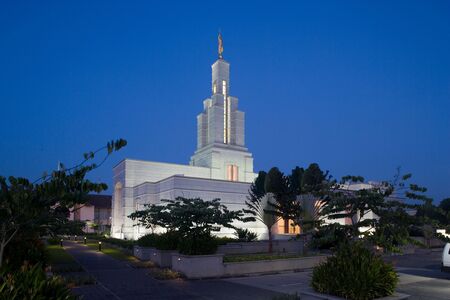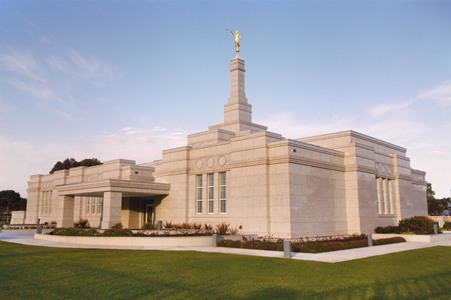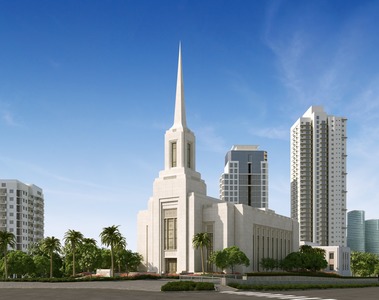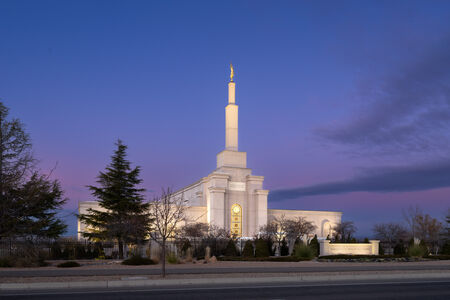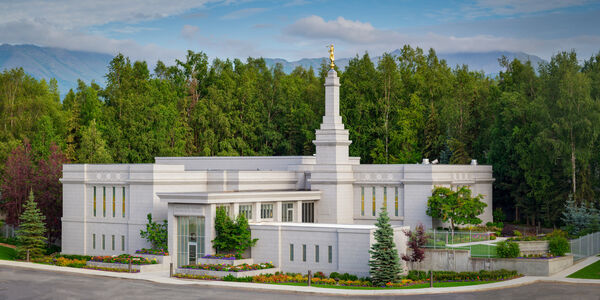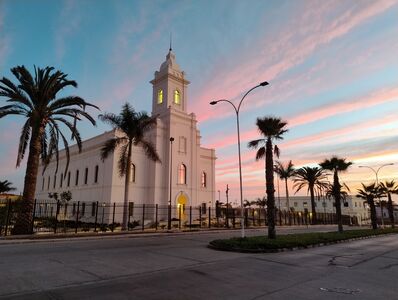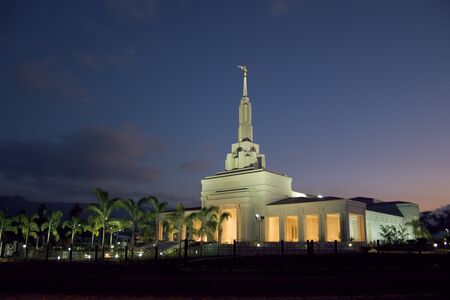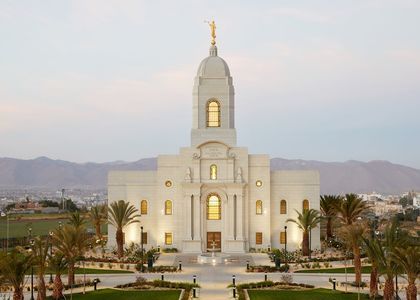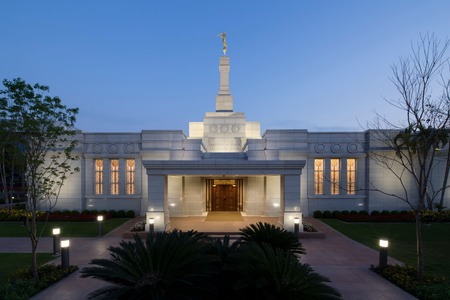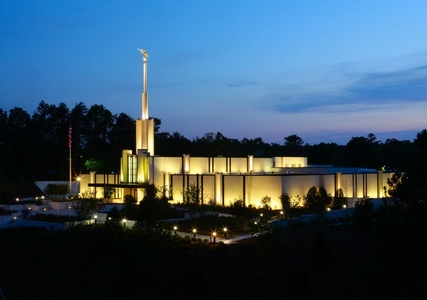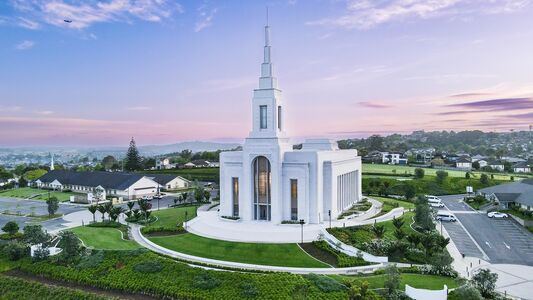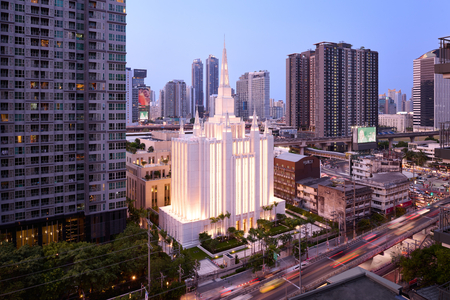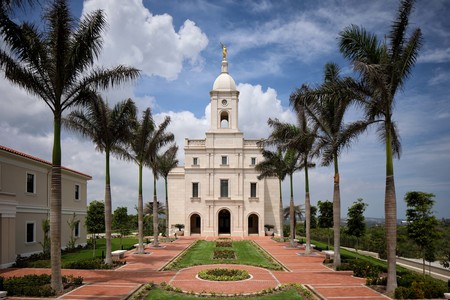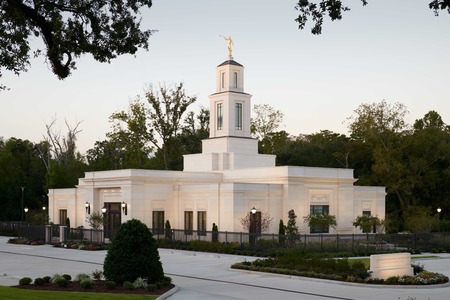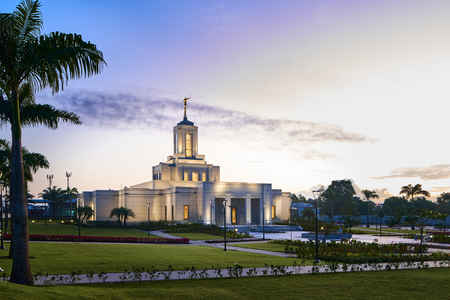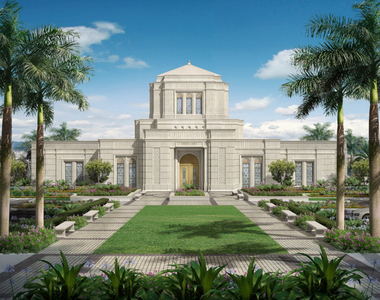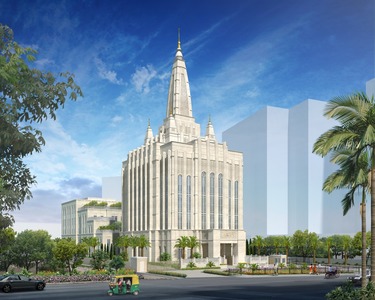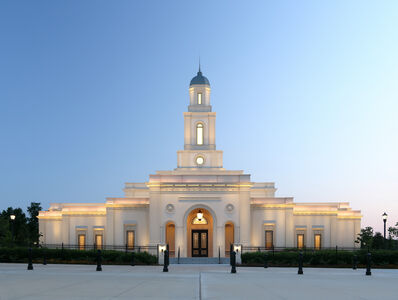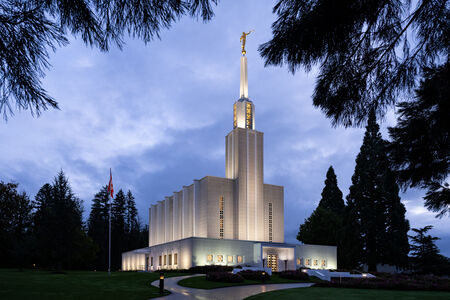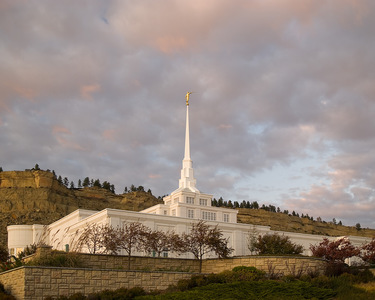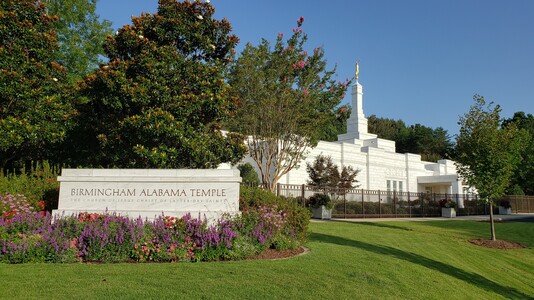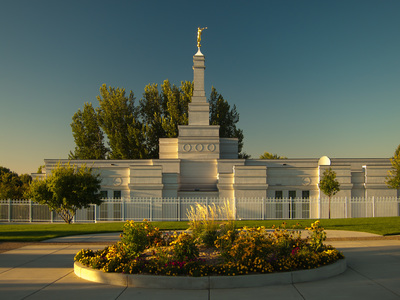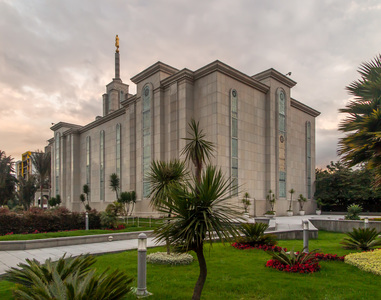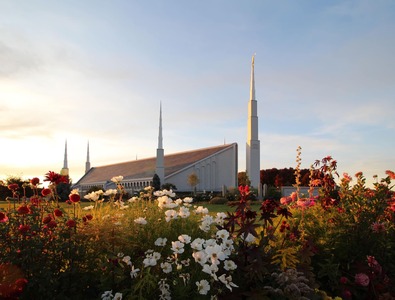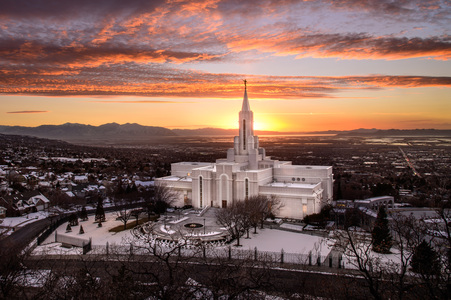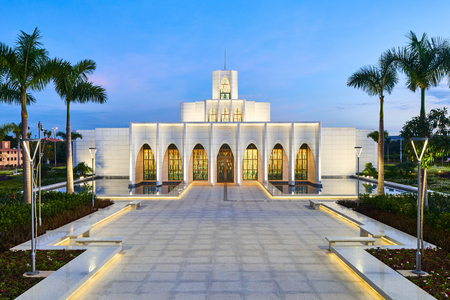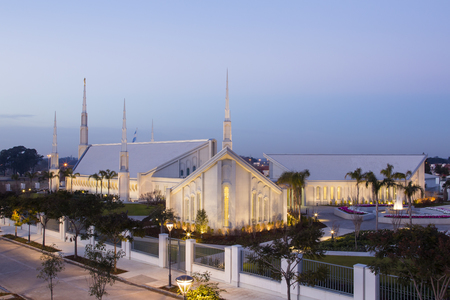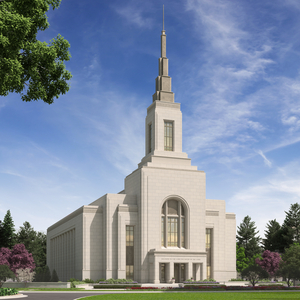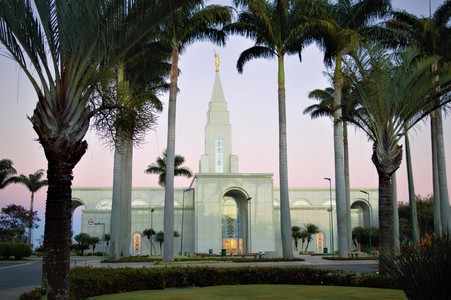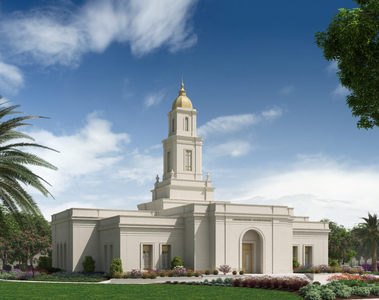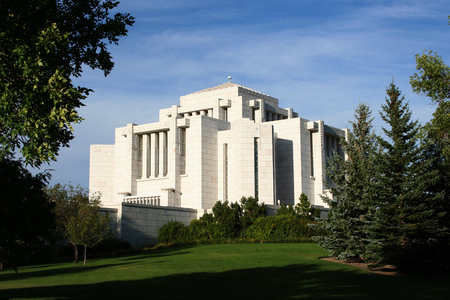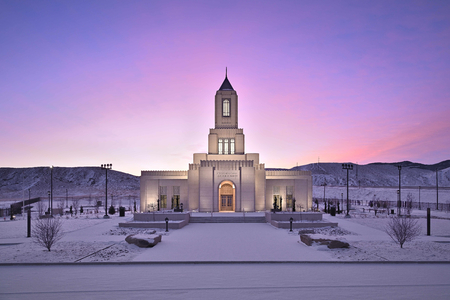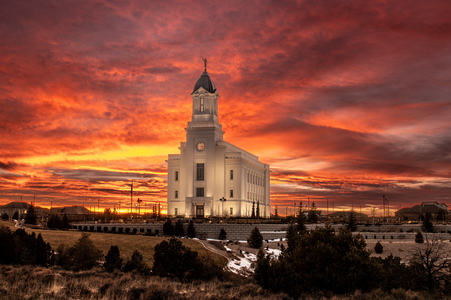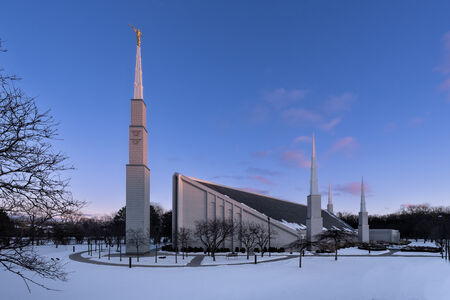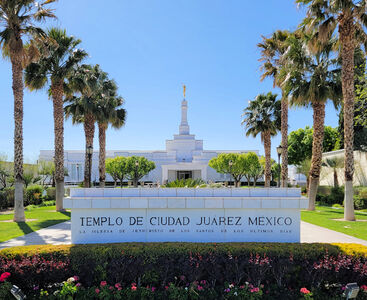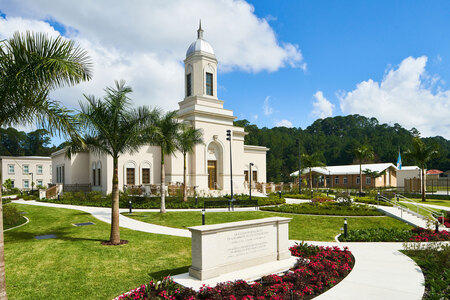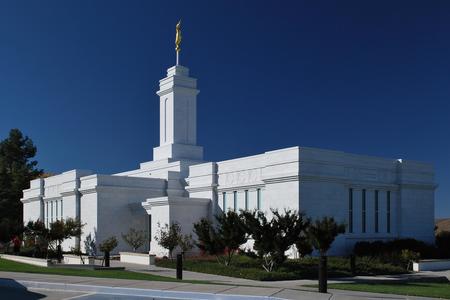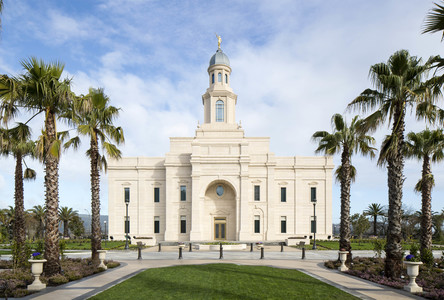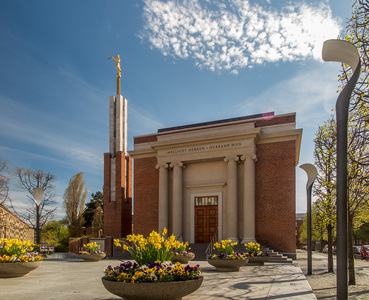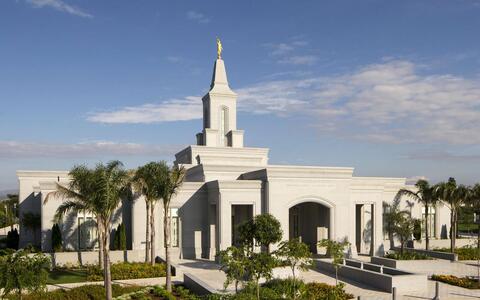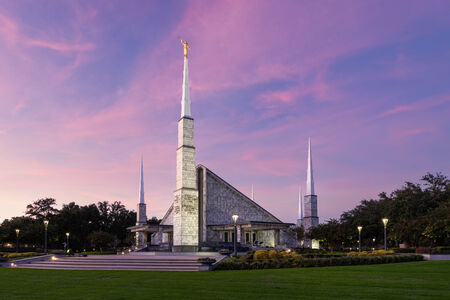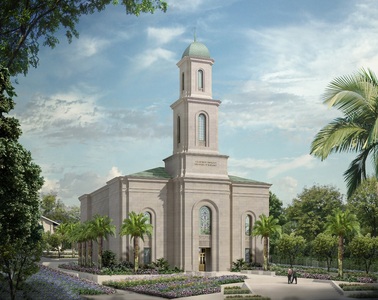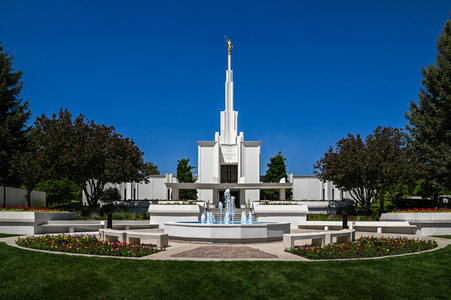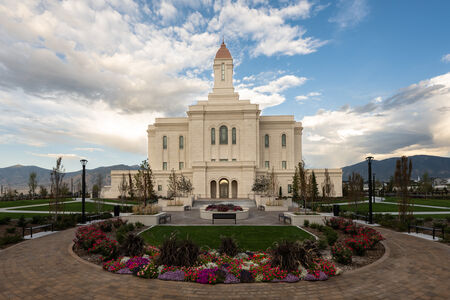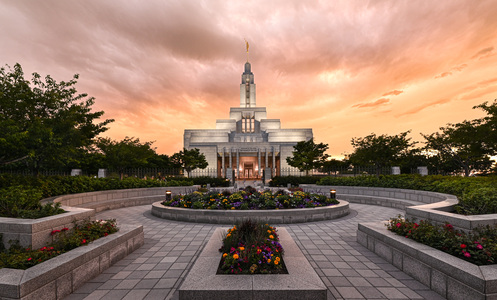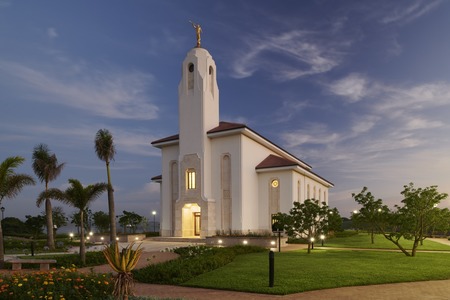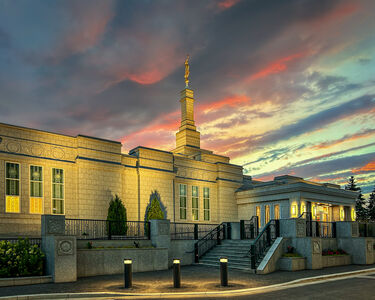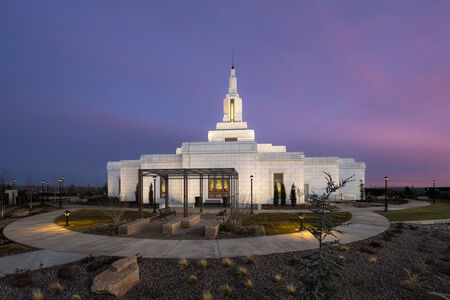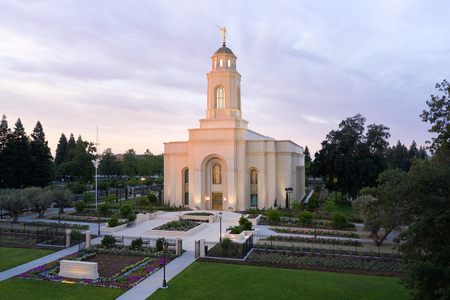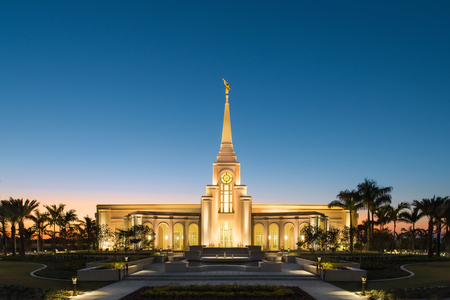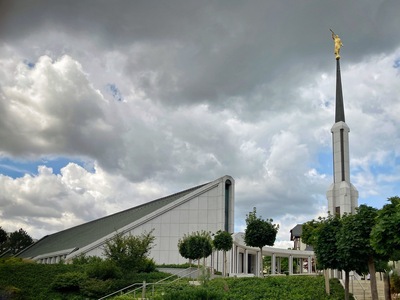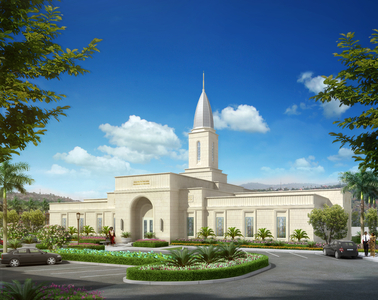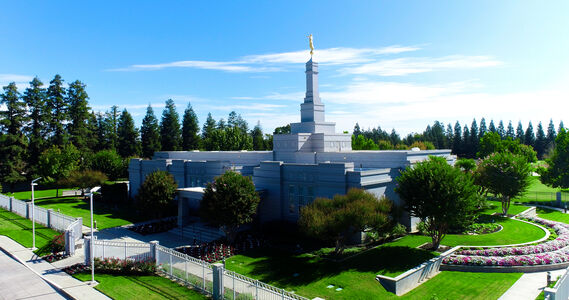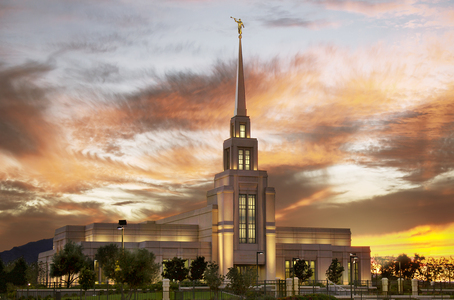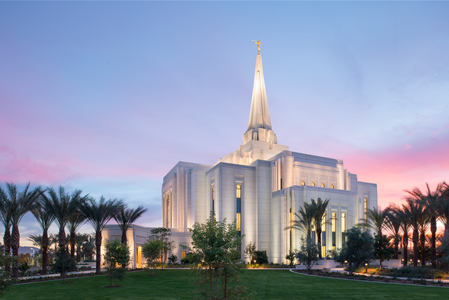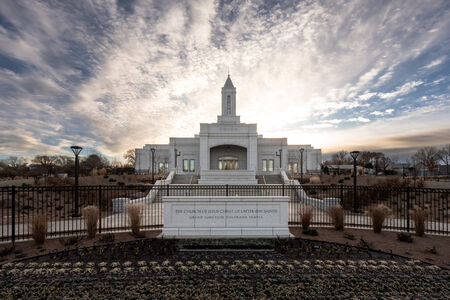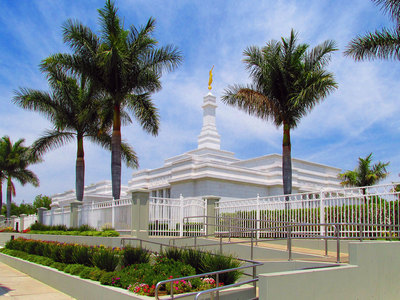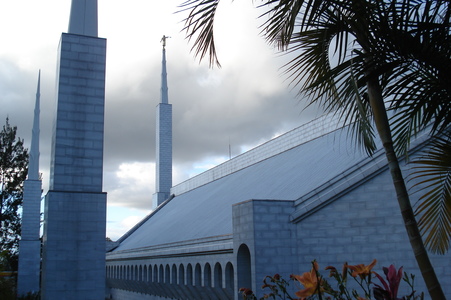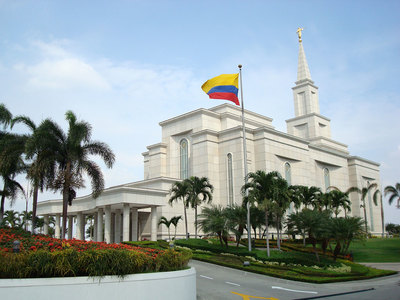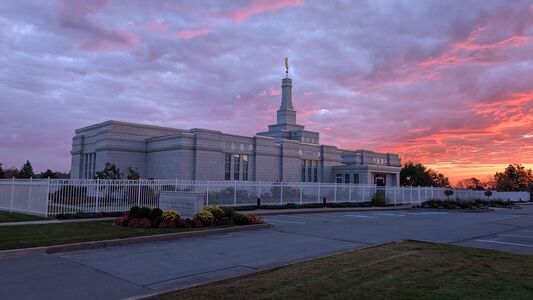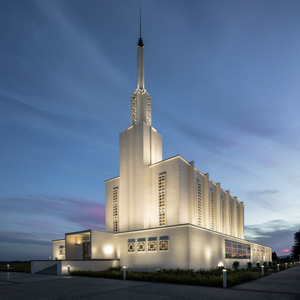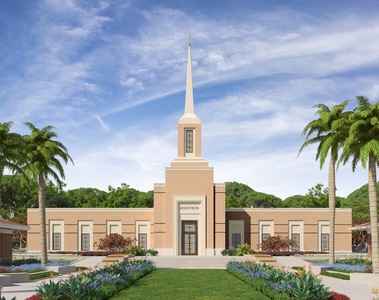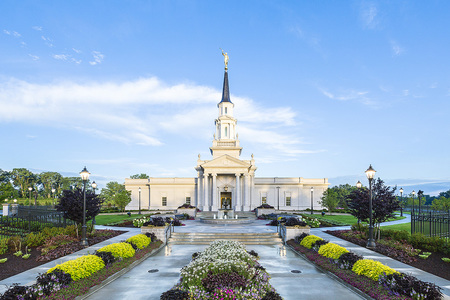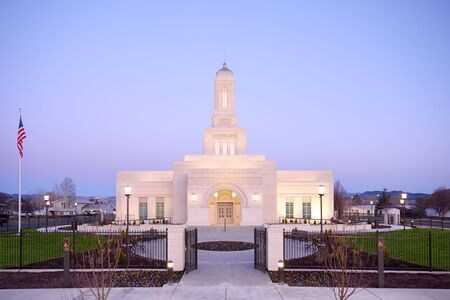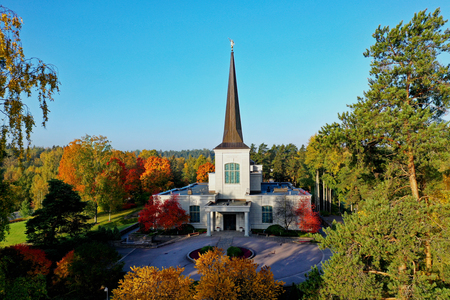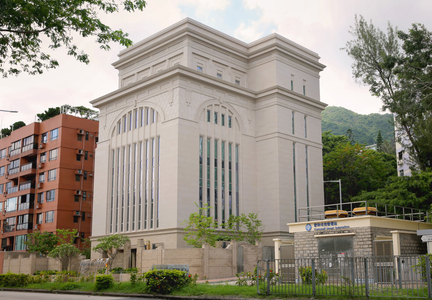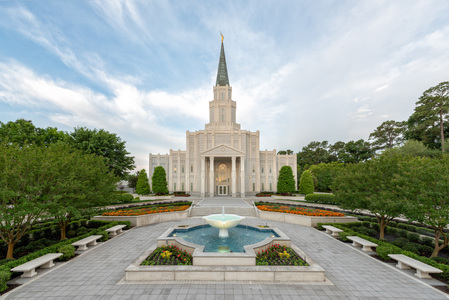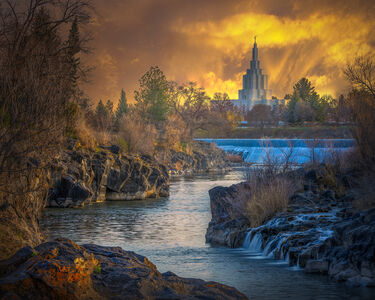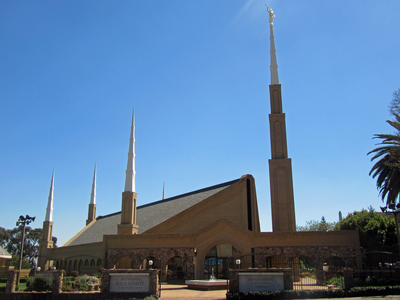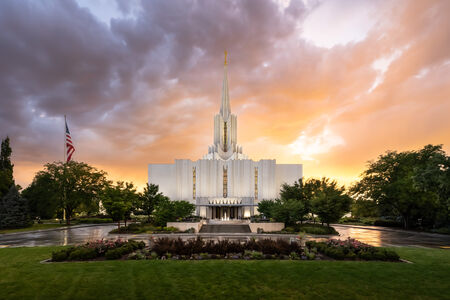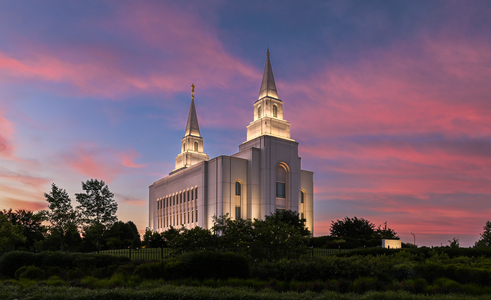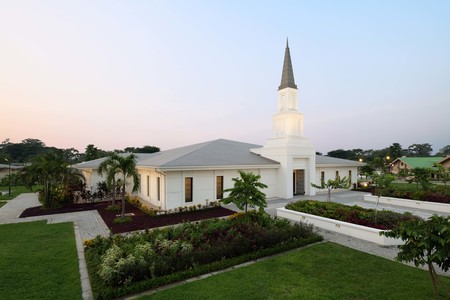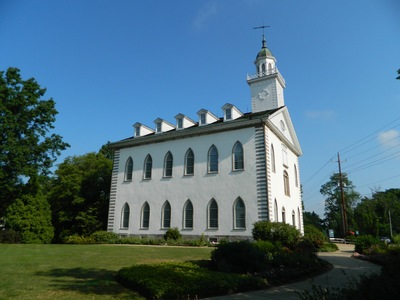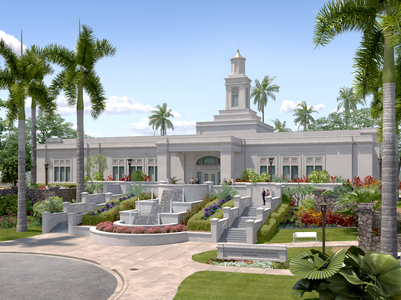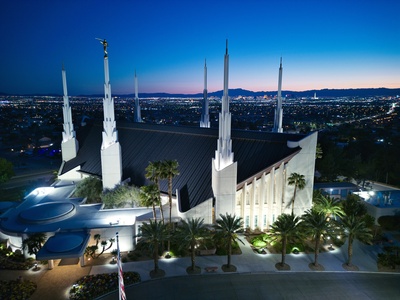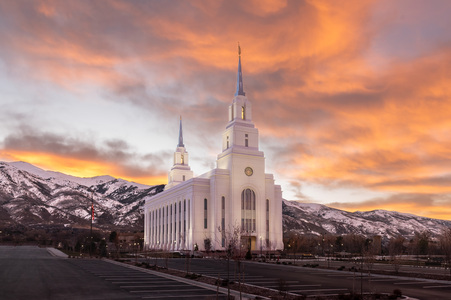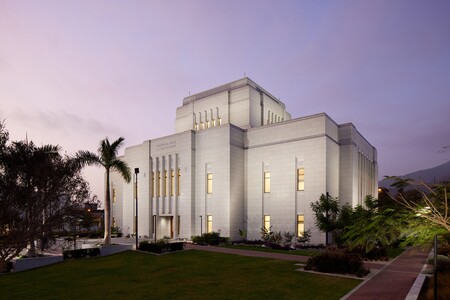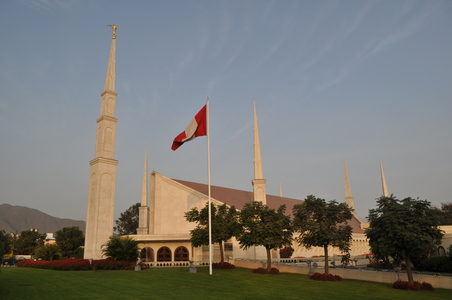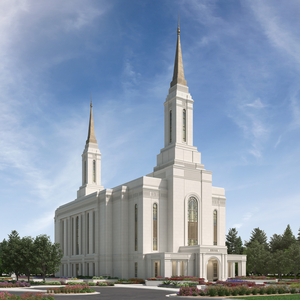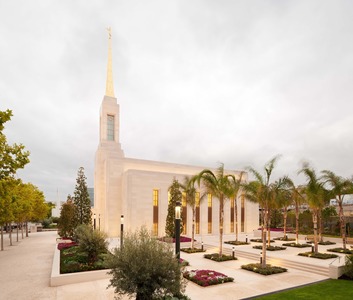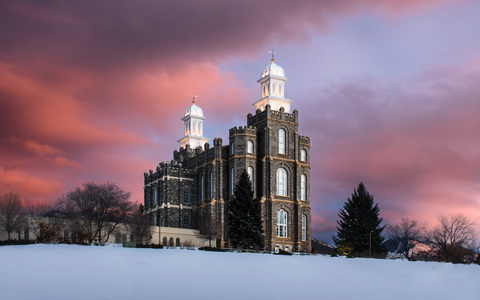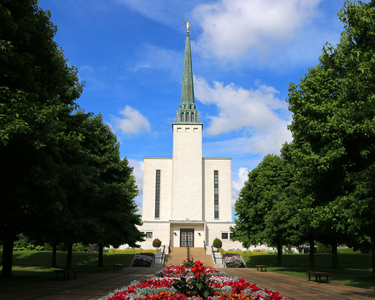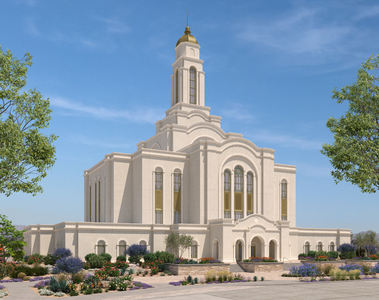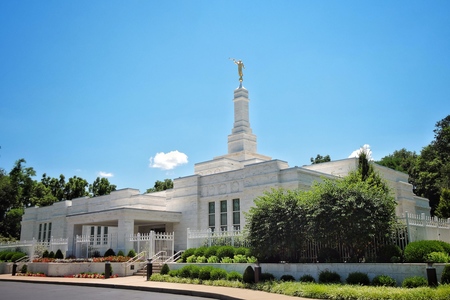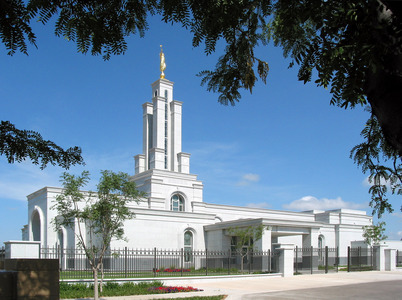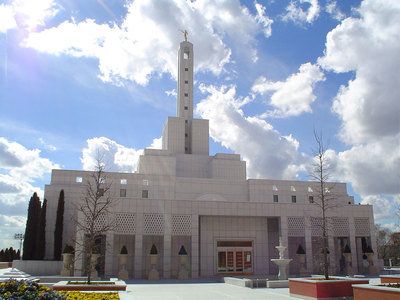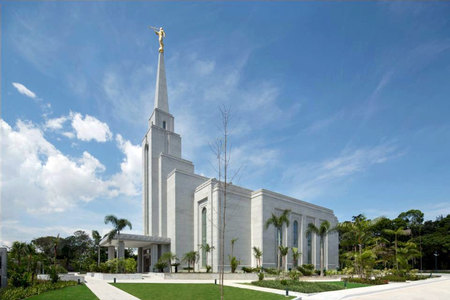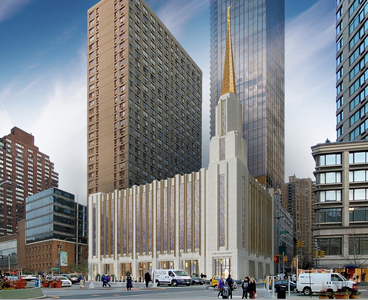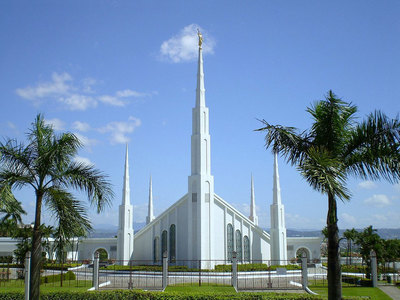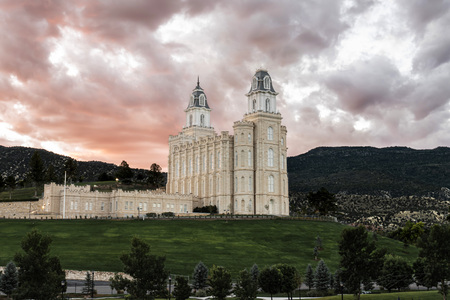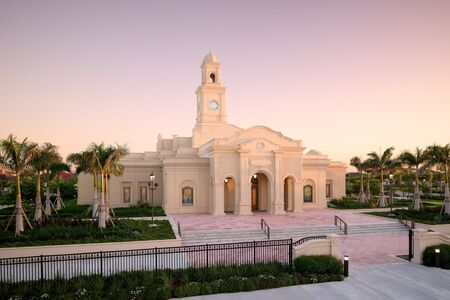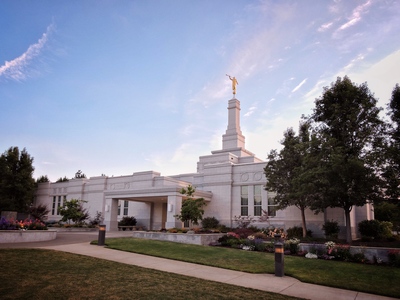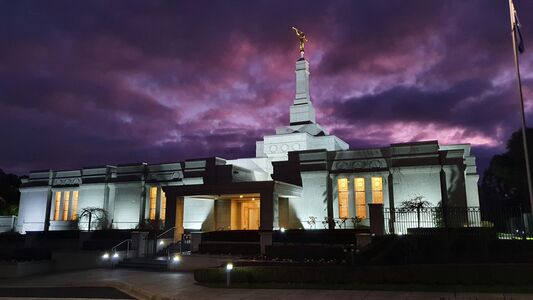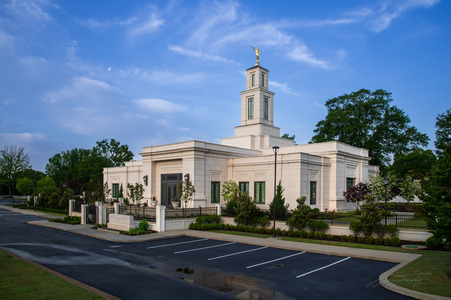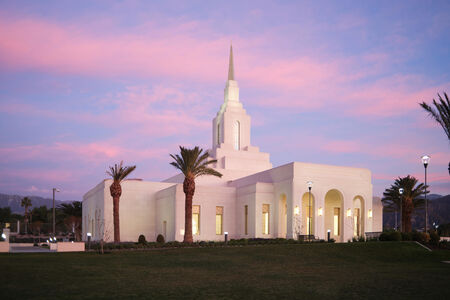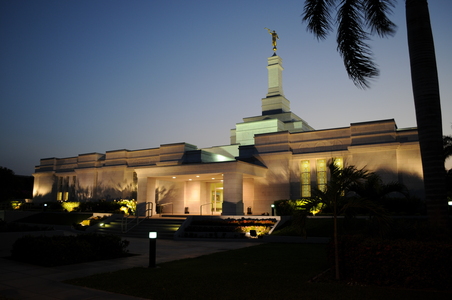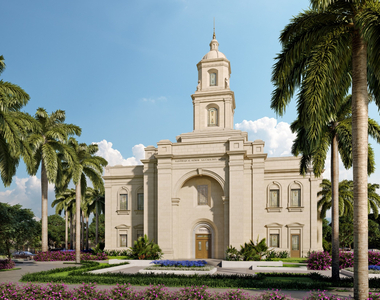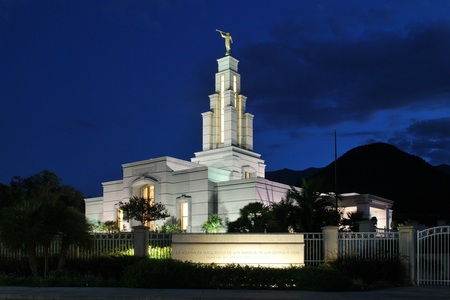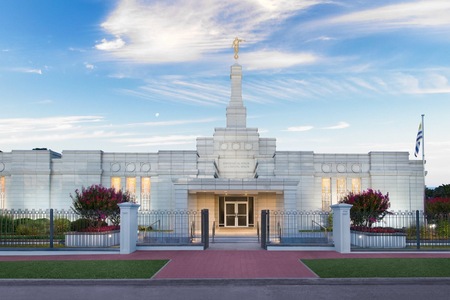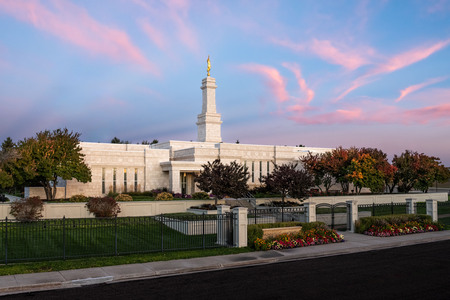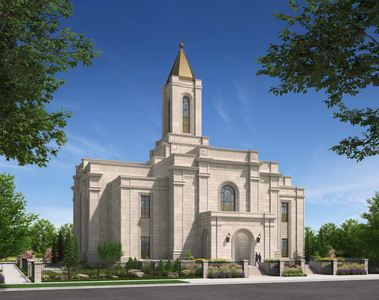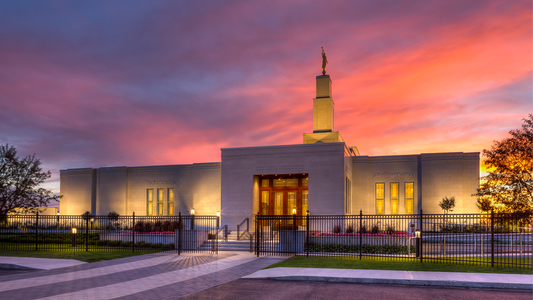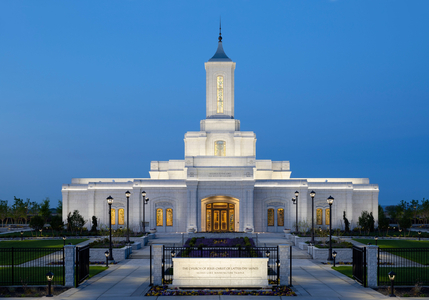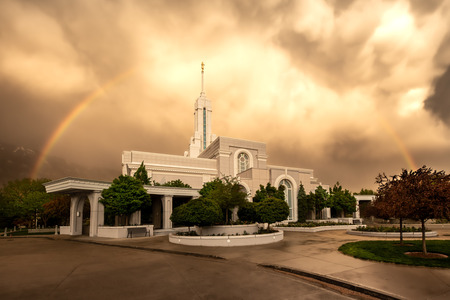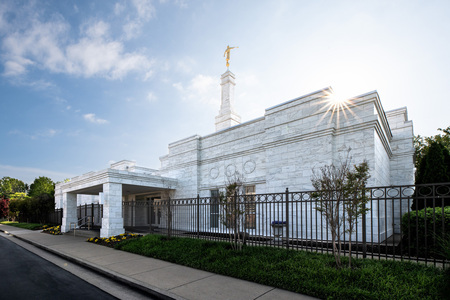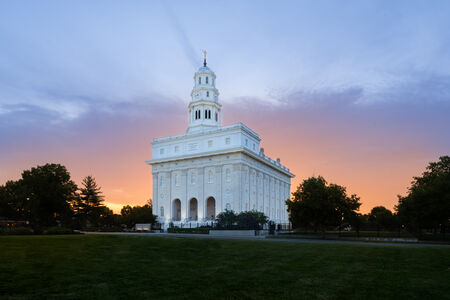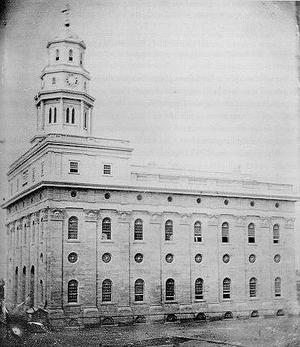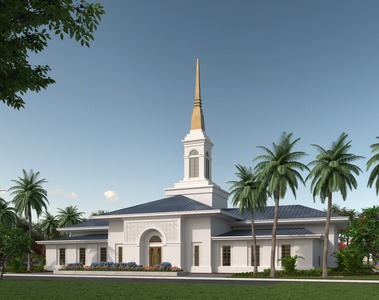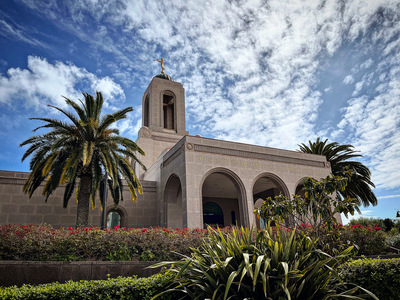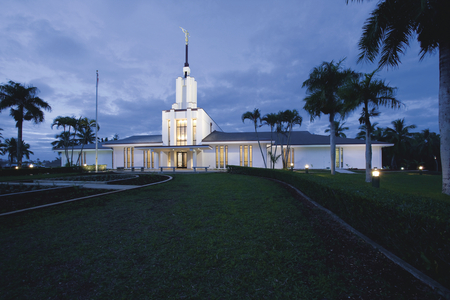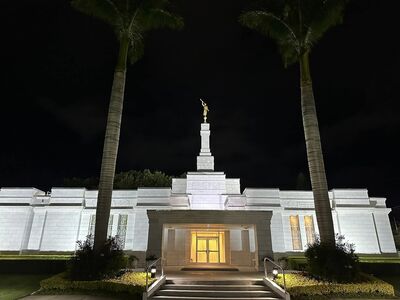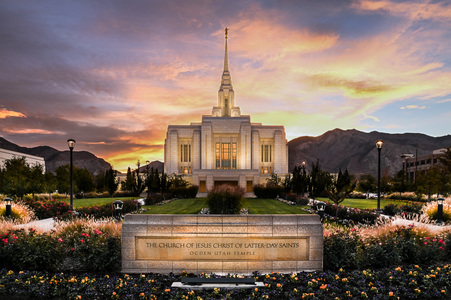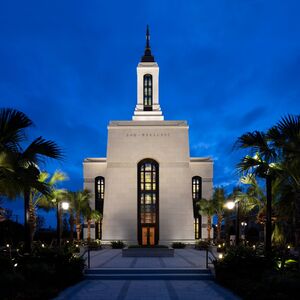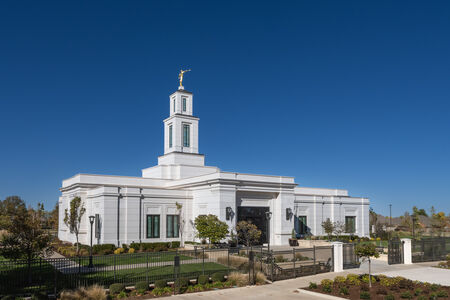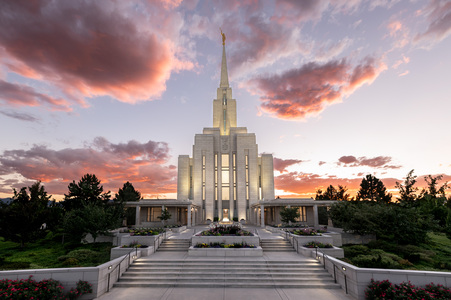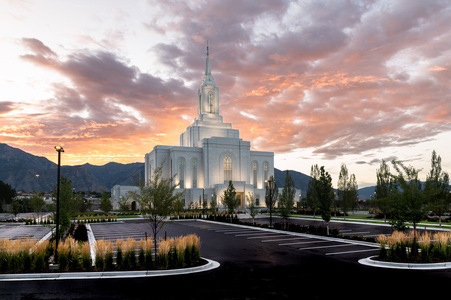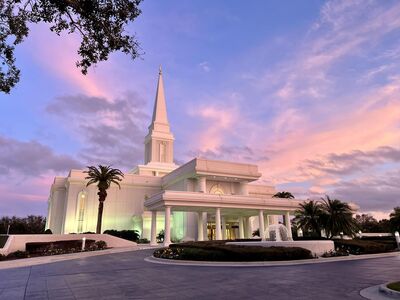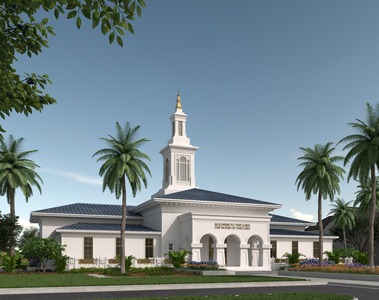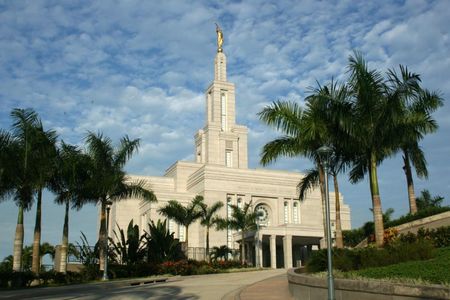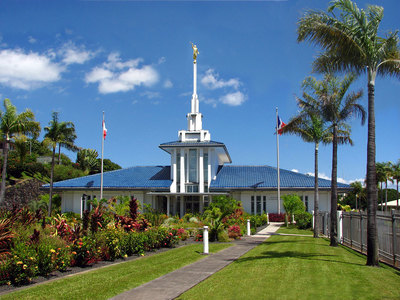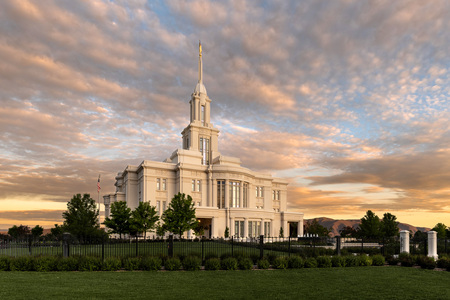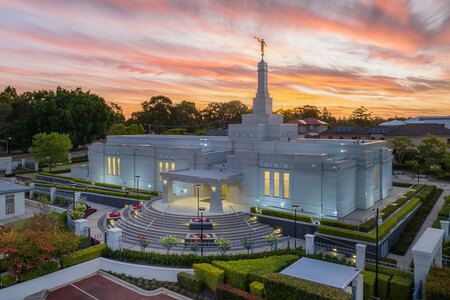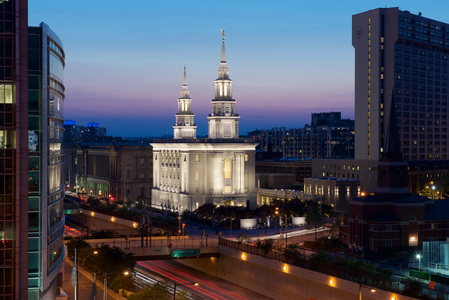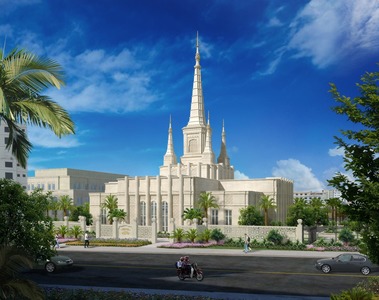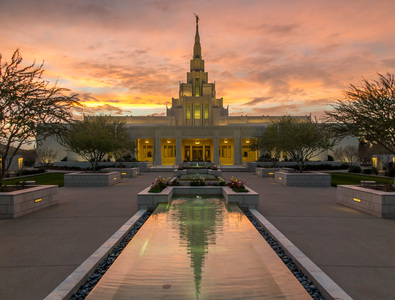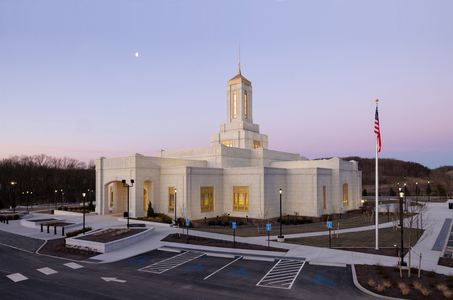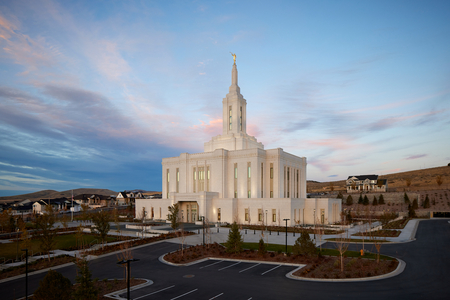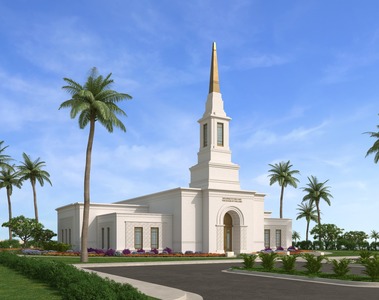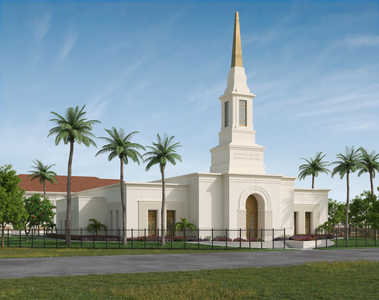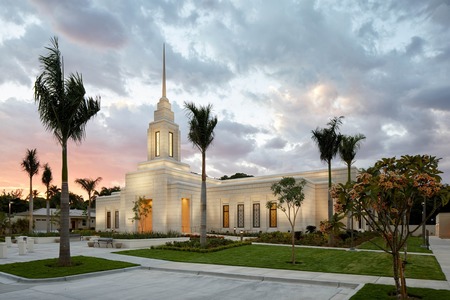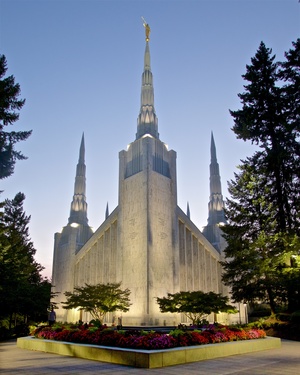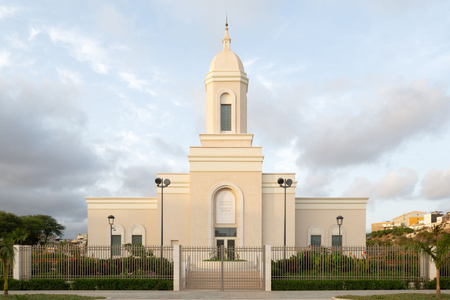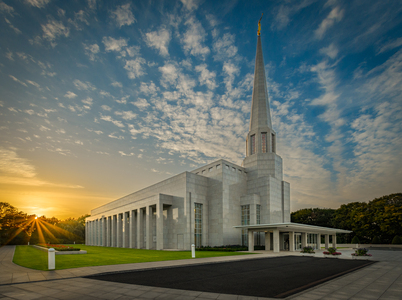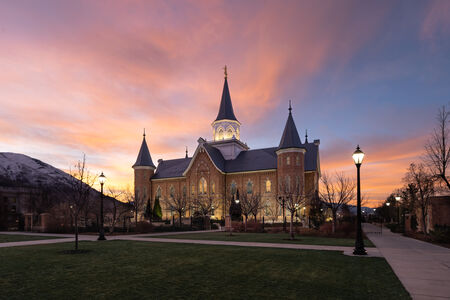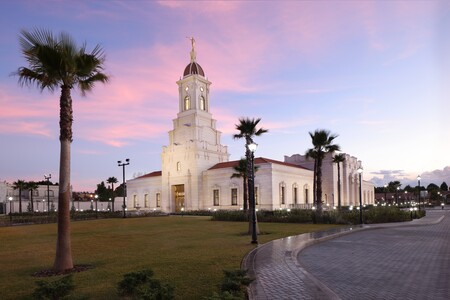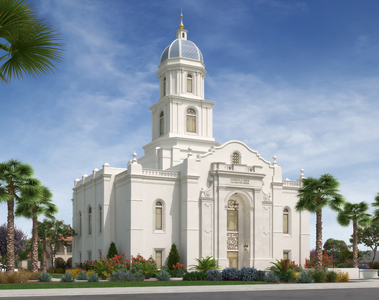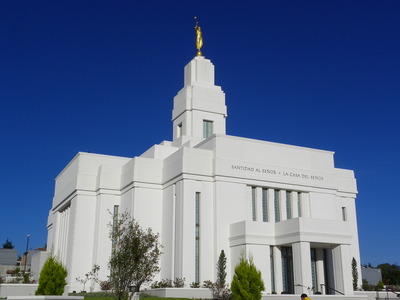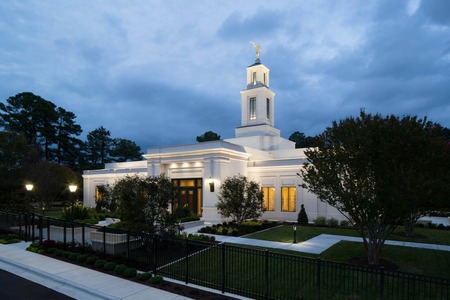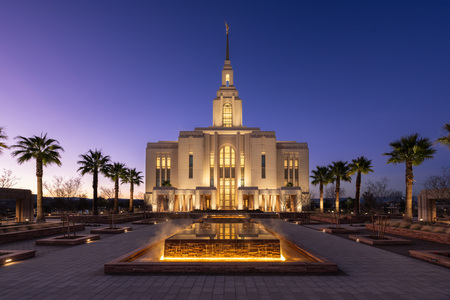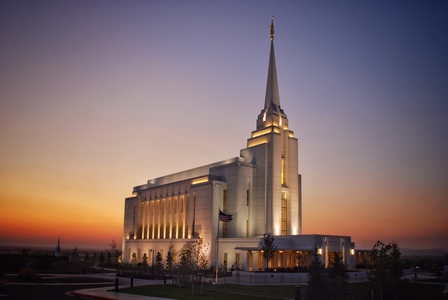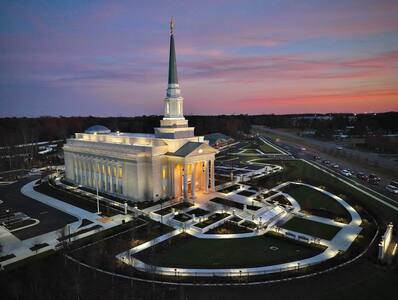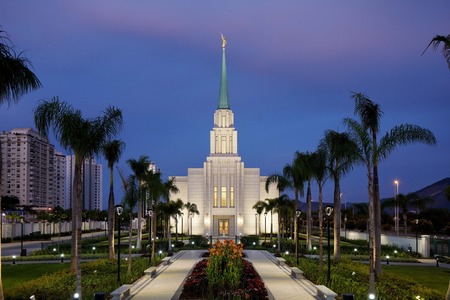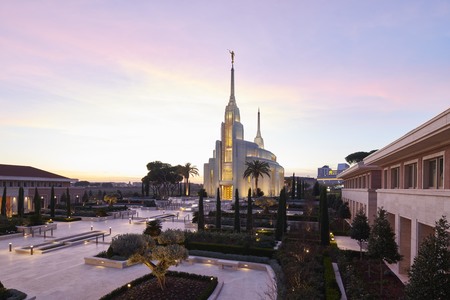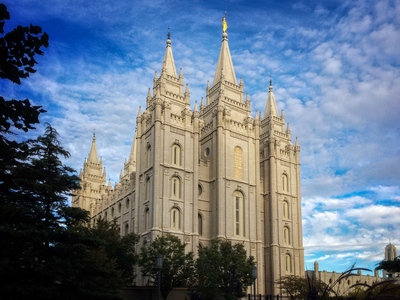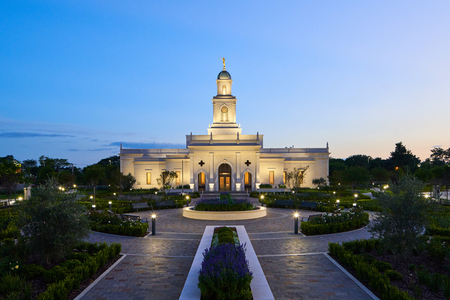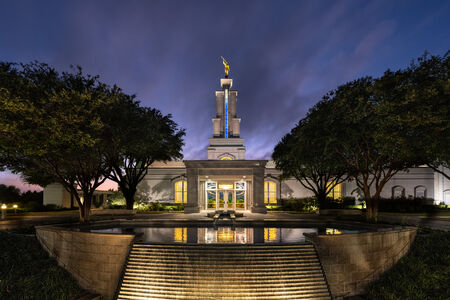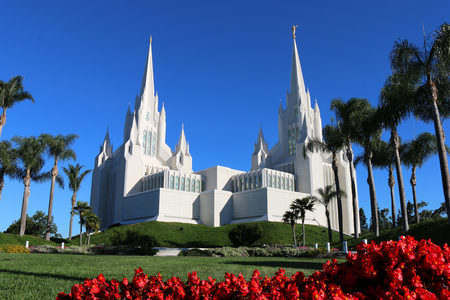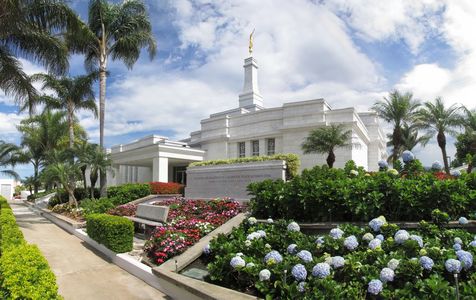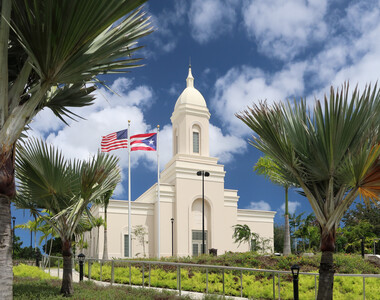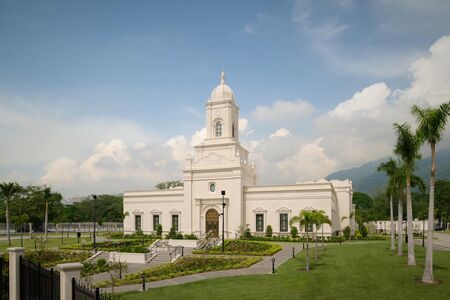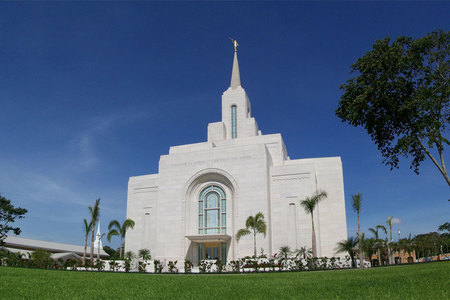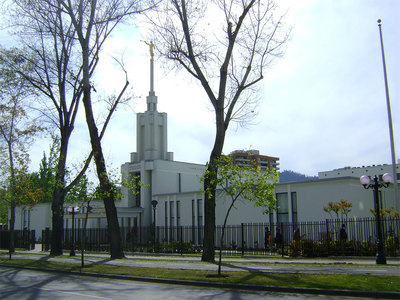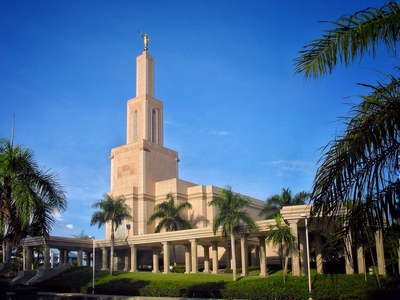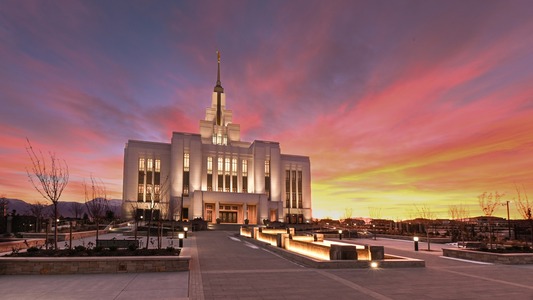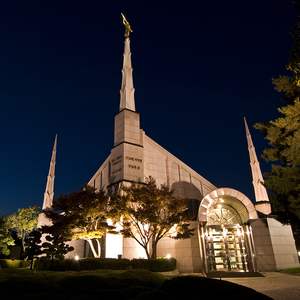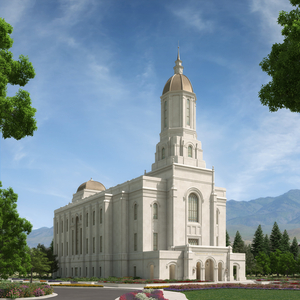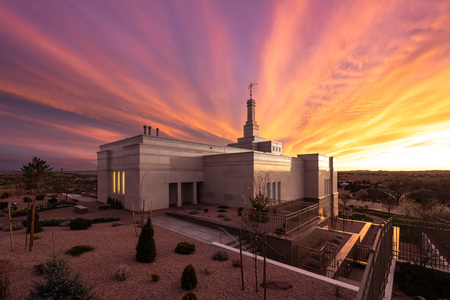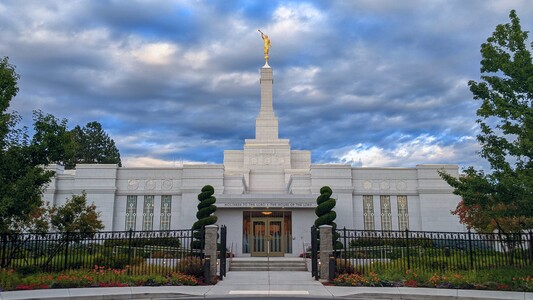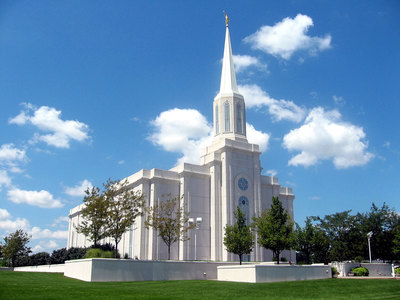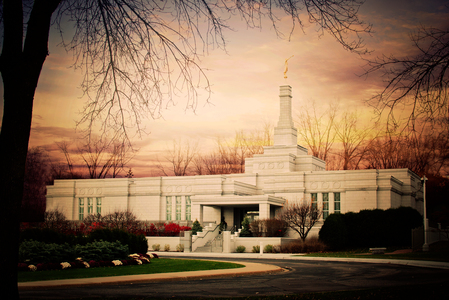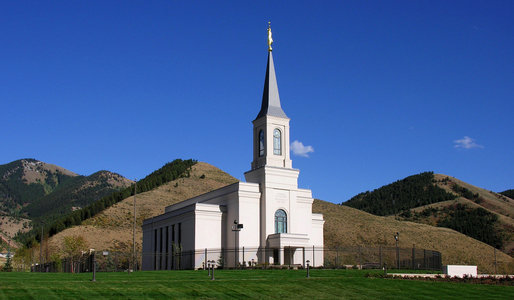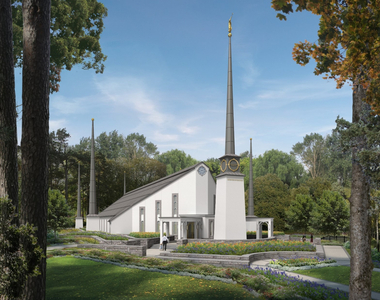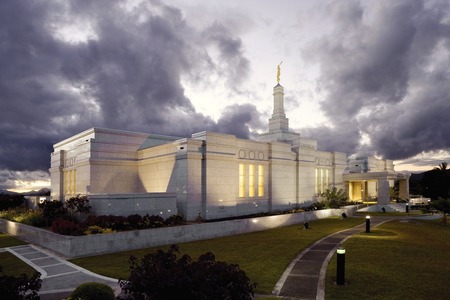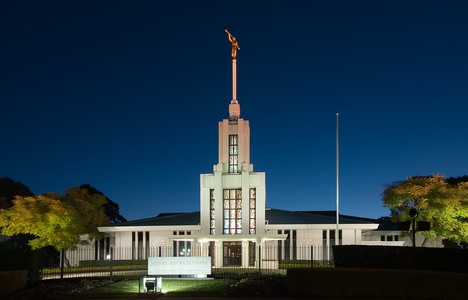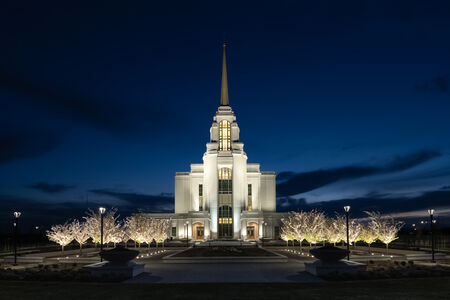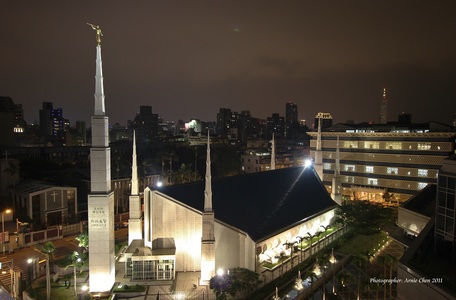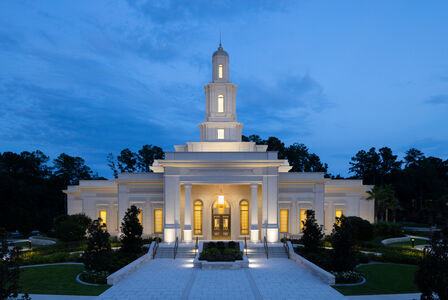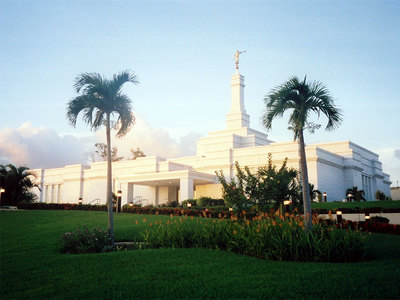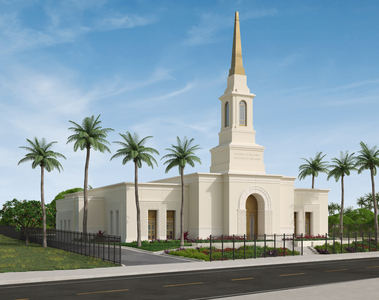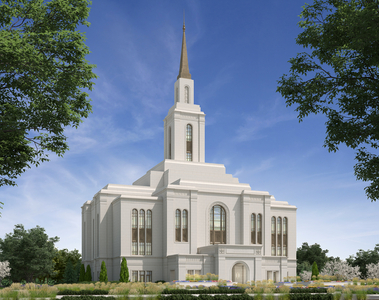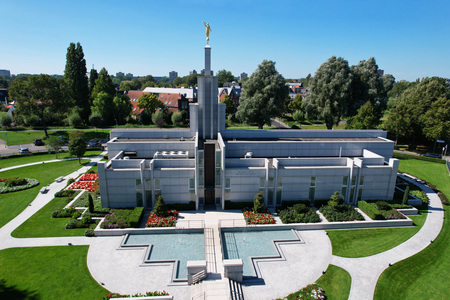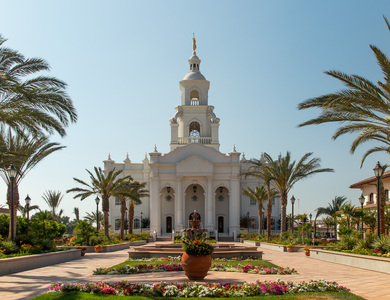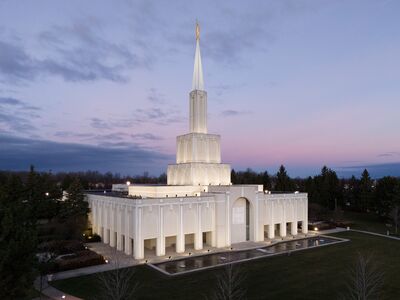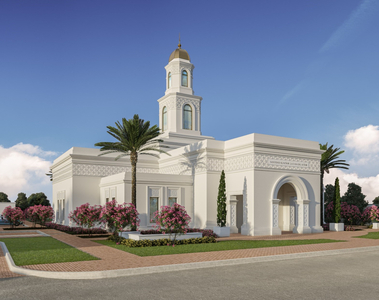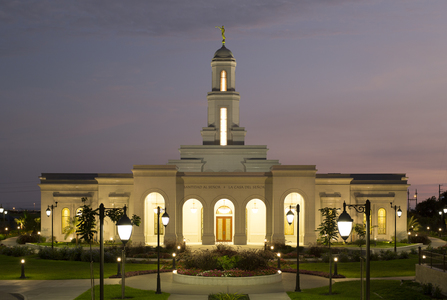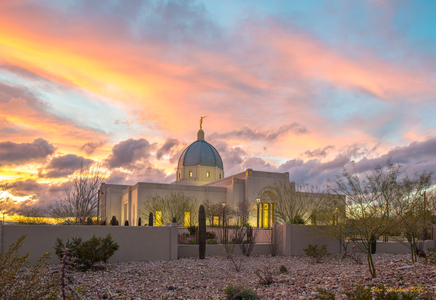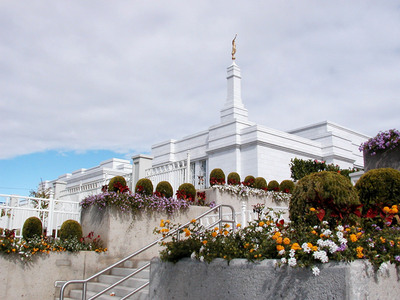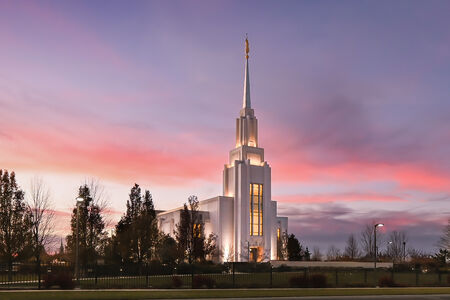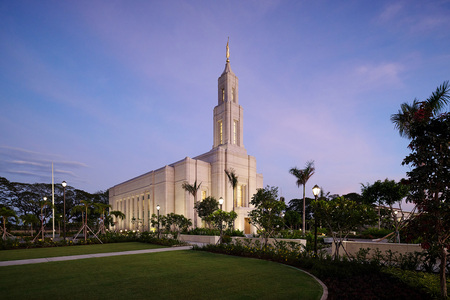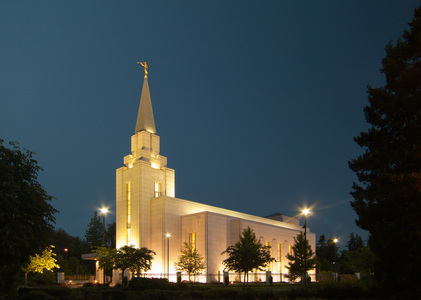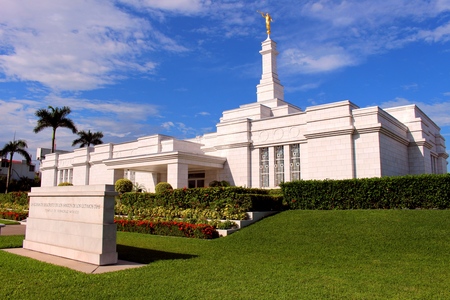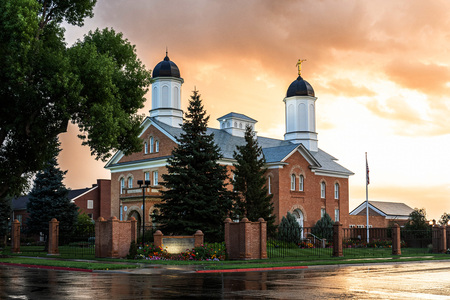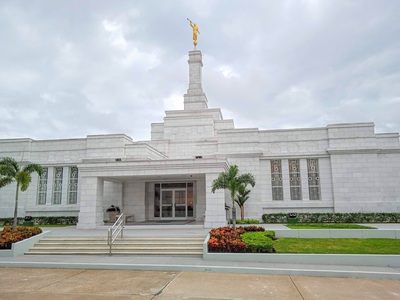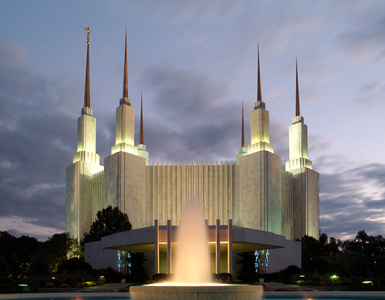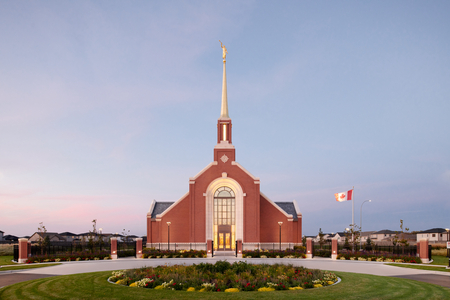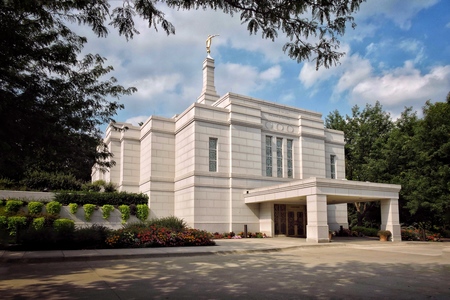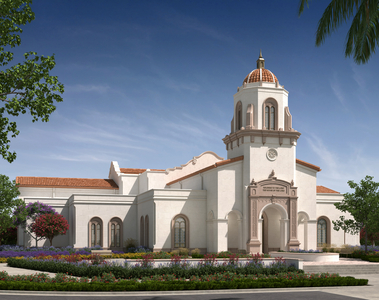Temple Designs
To meet the needs of a growing and diverse membership, The Church of Jesus Christ of Latter-day Saints has evolved its approach to temple construction and design over the years. This brief article examines major design phases of Latter-Day Saint temple construction.
Restoration Temples
The first temples of the modern Church were built as places of instruction and traditional worship, featuring large assembly and instruction halls. When the endowment ceremony was introduced, partitions were used to create the various stages of the endowment. These temples include the Kirtland Temple (1836), which fell out of Church ownership for than a century but was reacquired in 2024; the Nauvoo Temple (1846), which was destroyed by arson fire and rebuilt over 150 years later as the Nauvoo Illinois Temple (2002); and the St. George Utah Temple (1877), which has been remodeled inside to function as temples do today.
Pioneer Temples
To better function for the presentation of the endowment, temples built by the Utah pioneers featured progressive-style muraled endowment rooms where instruction was given by live presenters. Large priesthood assembly rooms remained a feature in these temples, located above the endowment rooms. East and west towers represented the priesthood while battlements along the north and south walls gave the appearance of a castle fortified against the forces of evil. These temples include the Logan Utah Temple (1884), Manti Utah Temple (1888), and Salt Lake Temple (1893).
Mormon Settlement Temples
After the turn of the century, the Church recognized the growth of its membership in more distant settlements by building a temple for the first time outside the state where Church headquarters was located. This temple—the Laie Hawaii Temple (1919)—was based on a design for a temple already under construction in Alberta, which retained progressive-style muraled endowment rooms but was much smaller, having no assembly hall nor any spires. Temple dedications followed the dedication in Hawaii for the Cardston Alberta Temple (1923), Mesa Arizona Temple (1927), and Idaho Falls Idaho Temple (1945). The Idaho Falls temple featured a central spire that was patterned after an ancient Nephite temple beheld by the architect in vision.
Overseas Temples
Taking a temple to Europe brought a special challenge, as the staff and training required to present the endowment in various languages would be too difficult in an area where Latter-days Saints were few and scattered. Gordon B. Hinckley was given the challenge to overcome this obstacle, which he did through inspiration, conceiving the idea of using film to present the endowment in a single assembly-style endowment room. The idea was first realized in the Bern Switzerland Temple (1955) and then followed in the Hamilton New Zealand Temple (1958) and London England Temple (1958). These temples have since been remodeled to include multiple stationary endowment rooms.
High-Efficiency Temples
In the late 1960s, it was clear that Utah's Pioneer temples were operating above capacity, and Church members east of the Rockies still had to come west to attend the temple. This burden was lightened with three new Utah temples and a temple on the east coast, each featuring escalators (since removed) and an unprecedented six endowment rooms: the Ogden Utah Temple (1972), Provo Utah Temple (1972), Washington D.C. Temple (1974), and Jordan River Utah Temple (1981).
Pacific Temples
Growth of the Church in the Pacific was recognized in the late 1970s, prompting the announcement of the Samoa Temple, which would serve as a regional temple for the Pacific Islands. After reconsideration, plans for this temple were replaced with plans for three smaller temples for the region: the Apia Samoa Temple (1983), Nuku'alofa Tonga Temple (1983), and Papeete Tahiti Temple (1983). This design was also taken to the east and west sides of the Pacific for the Santiago Chile Temple (1983) and Sydney Australia Temple (1984). The temple in Samoa has since been rebuilt, following a fire that destroyed the original building. Larger versions of this design were used for the Atlanta Georgia Temple (1983) and Denver Colorado Temple (1986).
Six-Spired Temples
President Spencer W. Kimball initiated an aggressive international temple building program in the mid-1980s using a detached six-spire, sloping roof design that brought temples to all habitable continents of the world for the first time. These temples include the Boise Idaho Temple (1984), Manila Philippines Temple (1984), Dallas Texas Temple (1984), Taipei Taiwan Temple (1984), Guatemala City Guatemala Temple (1984), Stockholm Sweden Temple (1985), Chicago Illinois Temple (1985), Johannesburg South Africa Temple (1985), Seoul Korea Temple (1985), Lima Peru Temple (1986), Buenos Aires Argentina Temple (1986), and Frankfurt Germany Temple (1987), which features a single detached spire only.
Landmark Temples
In the late 1980s and 1990s, some of the most architecturally stunning temples of the Church were designed, which have become high-profile landmarks in the locations where they were constructed. These regional temples would serve many members and were built accordingly. They include the Portland Oregon Temple (1989), Las Vegas Nevada Temple (1989), Toronto Ontario Temple (1990), San Diego California Temple (1993), Orlando Florida Temple (1994), Bountiful Utah Temple (1995), Hong Kong China Temple (1996), Mount Timpanogos Utah Temple (1996), St. Louis Missouri Temple (1997), Preston England Temple (1998), Madrid Spain Temple (1999), Bogotá Colombia Temple (1999), Guayaquil Ecuador Temple (1999), Billings Montana Temple (1999), Albuquerque New Mexico Temple (2000), Cochabamba Bolivia Temple (2000), Houston Texas Temple (2000), Santo Domingo Dominican Republic Temple (2000), Boston Massachusetts Temple (2000), Recife Brazil Temple (2000), and Campinas Brazil Temple (2002).
Smaller and Remote-Area Temples
President Gordon B. Hinckley's announcement of "smaller and remote-area" temples in the late 1990s represented a major shift from the large landmark temples that had been designed up to that point and were still under construction. Shortly after the announcement, the 6,800-square-foot Monticello Utah Temple (1998) was constructed in just eight months as a pilot temple for the new concept. It featured one endowment room, one sealing room, and a baptistry with a white fiberglass angel Moroni statue. No cafeteria, clothing rental, or laundry facility were included. Similarly designed buildings followed with distinct spires and exteriors including the Anchorage Alaska Temple (1999) and Colonia Juárez Chihuahua Mexico Temple (1999). The Monticello and Anchorage temples have since been enlarged to two endowment rooms, and the white angel on Monticello was replaced with a gold-leafed version.
Converted Temples
The Vernal Utah Temple (1997) was the first temple constructed from an existing Church building. The challenge of converting the narrow Uintah Stake Tabernacle gave rise to the concept of in-line, progressive-style endowment rooms, which would inspire the next generation of smaller temples. The second temple converted from an existing building was the Copenhagen Denmark Temple (2004). It was constructed from the historic neo-classical Priorvej chapel. The Manhattan New York Temple (2004), which was constructed on the top three floors of a Church-owned office building near Lincoln Center, followed shortly thereafter. Finally, the burned-out shell of the Provo Tabernacle became the Provo City Center Temple (2016) twelve years later.
Standardized Temples
Utilizing the concept of progressive-style endowment rooms conceived during the construction of the Vernal Utah Temple (1997), a 10,700-square-foot temple floor plan with two endowment rooms and two sealing rooms was created as a standard plan for smaller temples that was built the world over. Church-owned property next to existing meetinghouses was often selected for these temples, allowing parking to be shared and temple grounds to be scaled down.
There were 43 temples built on this design including the Spokane Washington Temple (1999), Columbus Ohio Temple (1999), Bismarck North Dakota Temple (1999), Columbia South Carolina Temple (1999), Detroit Michigan Temple (1999), Halifax Nova Scotia Temple (1999), Regina Saskatchewan Temple (1999), Edmonton Alberta Temple (1999), Raleigh North Carolina Temple (1999), St. Paul Minnesota Temple (2000), Kona Hawaii Temple (2000), Ciudad Juárez Mexico Temple (2000), Hermosillo Sonora Mexico Temple (2000), Oaxaca Mexico Temple (2000), Tuxtla Gutiérrez Mexico Temple (2000), Louisville Kentucky Temple (2000), Palmyra New York Temple (2000), Fresno California Temple (2000), Medford Oregon Temple (2000), Memphis Tennessee Temple (2000), Reno Nevada Temple (2000), Tampico Mexico Temple (2000), Nashville Tennessee Temple (2000), Villahermosa Mexico Temple (2000), Montreal Quebec Temple (2000), San José Costa Rica Temple (2000), Fukuoka Japan Temple (2000), Adelaide Australia Temple (2000), Melbourne Australia Temple (2000), Suva Fiji Temple (2000), Mérida Mexico Temple (2000), Veracruz Mexico Temple (2000), Baton Rouge Louisiana Temple (2000), Oklahoma City Oklahoma Temple (2000), Birmingham Alabama Temple (2000), Porto Alegre Brazil Temple (2000), Montevideo Uruguay Temple (2001), Guadalajara Mexico Temple (2001), Perth Australia Temple (2001), Asunción Paraguay Temple (2002), The Hague Netherlands Temple (2002), Brisbane Australia Temple (2003), and Aba Nigeria Temple (2005).
Four additional temples were built as a two-story adaptation of this plan including the Caracas Venezuela Temple (2000), Winter Quarters Nebraska Temple (2001), Snowflake Arizona Temple (2002), and Quetzaltenango Guatemala Temple (2011). Many of these temples have since been remodeled to alter the exterior appearance and update the interior.
New Millennium Temples
The new millennium brought an enlargement to the standard plan of about 7,000 square feet, and a customized approach to design was embraced at this time. Temple exteriors reflected the hertiage of the region and featured impressive spires. Murals were brought back to endowment rooms, and distinctive art glass was created for each building. This design is seen in the Columbia River Washington Temple (2001), Lubbock Texas Temple (2002), Monterrey Mexico Temple (2002), Redlands California Temple (2003), Accra Ghana Temple (2004), San Antonio Texas Temple (2005), Newport Beach California Temple (2005), Sacramento California Temple (2006), and Helsinki Finland Temple (2006).
Progressive Temples
While the construction of smaller temples brought temple blessings closer to the Saints, rapid growth in regions of more concentrated Church membership prompted the retirement of the standard floor plan. Architects and designers were tasked with creating larger progressive-style temples with bold interiors and exteriors that honored the culture of the region including custom murals, artwork, stained glass, and architectural features that centered around a particular theme or motif. The first dedicated temple of this era was the wheat-themed Rexburg Idaho Temple (2008). The Twin Falls Idaho Temple (2008), which features a waterfall motif, was dedicated a few months later. The following year, a pair of temples were dedicated in Utah: the Draper Utah Temple (2009) and Oquirrh Mountain Utah Temple (2009).
Similarly designed temples during this time included the stunning double-towered Kansas City Missouri Temple (2012), Brigham City Utah Temple (2012), Philadelphia Pennsylvania Temple (2016), and Rome Italy Temple (2019). Several single-level temples were constructed in the United States including a small end-spire floor plan for The Gila Valley Arizona Temple (2010); a larger end-spire floor plan for the Fort Lauderdale Florida Temple (2014), Indianapolis Indiana Temple (2015), and Hartford Connecticut Temple (2016); and yet a larger plan for the Fort Collins Colorado Temple (2016).
Progressive temples were also built across Latin America including two-level, center-tower designs for the Panama City Panama Temple (2008), San Salvador El Salvador Temple (2011), Tegucigalpa Honduras Temple (2013), and Tijuana Mexico Temple (2015); a single-level, center-tower design for the Córdoba Argentina Temple (2015) and Trujillo Peru Temple (2015); and an end-spire design for the Curitiba Brazil Temple (2008) and Manaus Brazil Temple (2012)—also seen in the Vancouver British Columbia Temple (2010).
Some especially unique designs during this era included the Phoenix Arizona Temple (2014), Sapporo Japan Temple (2016), Paris France Temple (2017), and Meridian Idaho Temple (2017).
Stationary Temples
By the early 2010s, temple architects were asked to create more efficient, appropriately sized floor plans. Muraled progressive endowment rooms were replaced with stationary rooms to increase the frequency of endowment sessions in temples both large and small. For the first time since the construction of the Colonia Juárez Chihuahua Mexico Temple (1999), temples were constructed with a single endowment room including the Star Valley Wyoming Temple (2016), Kinshasa Democratic Republic of the Congo Temple (2019), Port-au-Prince Haiti Temple (2019), Durban South Africa Temple (2020), and Winnipeg Manitoba Temple (2020). The largest temples since the construction of the Mount Timpanogos Utah Temple (1996) were also constructed during this period including the Gilbert Arizona Temple (2014) and Payson Utah Temple (2015).
In 2017, two temples were dedicated in the United States. The Tucson Arizona Temple (2017) was the first temple to be constructed with a large central dome, and the Cedar City Utah Temple (2017) was a tribute to Pioneer architecture and decor. Europe saw the addition of the beautifully modern Lisbon Portugal Temple (2019). And five temples were constructed in Latin America including two-level, end-tower designs for the Barranquilla Colombia Temple (2018), Fortaleza Brazil Temple (2019), and Rio de Janeiro Brazil Temple (2022); and two-level, center-tower designs for the Concepción Chile Temple (2018) and Arequipa Peru Temple (2019).
Functional Temples
The 2020s saw the development of several new standard floor plans with innovations to increase function and flexibility in ordinance work. For the first time, large floor plans were developed with two baptistries while smaller plans were designed with multiuse spaces. Modular construction was also pioneered at this time, bringing high-quality craftsmanship to remote locations through the shipment of prefabricated modules.
- Modular Temples included a central-spire design used for the Helena Montana Temple, Casper Wyoming Temple, Elko Nevada Temple, Torreón Mexico Temple, Cali Colombia Temple, Cape Town South Africa Temple, and Phnom Penh Cambodia Temple. An end-spire design was used for the Port Moresby Papua New Guinea Temple, Tarawa Kiribati Temple, and Port Vila Vanuatu Temple in the Pacific.
- Remote-Area Temples included the Yigo Guam Temple, Praia Cape Verde Temple, San Juan Puerto Rico Temple, and Cobán Guatemala Temple.
- Smaller, Single-Level Temples included the Harare Zimbabwe Temple, Pago Pago American Samoa Temple, Neiafu Tonga Temple, Nairobi Kenya Temple, and Freetown Sierra Leone Temple.
- Smaller, Two-Story Temples included the Davao Philippines Temple and Antofagasta Chile Temple.
- Mid-Sized, Central-Spire Temples included the Belém Brazil Temple, Quito Ecuador Temple, Brasília Brazil Temple, Moses Lake Washington Temple, Salta Argentina Temple, Bentonville Arkansas Temple, McAllen Texas Temple, Mendoza Argentina Temple, Tallahassee Florida Temple, Pittsburgh Pennsylvania Temple, Grand Junction Colorado Temple, Farmington New Mexico Temple, Yorba Linda California Temple, and Willamette Valley Oregon Temple.
- Mid-Sized, End-Spire Temples included the Puebla Mexico Temple and San Pedro Sula Honduras Temple.
- Two-Story, Central-Spire Temples included the Miraflores Guatemala City Guatemala Temple, Salvador Brazil Temple, Querétaro Mexico Temple, and Montpelier Idaho Temple.
- Two-Story, End-Spire Temples included the Richmond Virginia Temple, Feather River California Temple, Urdaneta Philippines Temple (different floor plan), Auckland New Zealand Temple, Alabang Philippines Temple, and Burley Idaho Temple.
- Three-Story, Central-Spire Temples included the Pocatello Idaho Temple, Orem Utah Temple, Taylorsville Utah Temple, Deseret Peak Utah Temple, and Lone Mountain Nevada Temple.
- Dual-Baptistry Temples included the Syracuse Utah Temple, Lindon Utah Temple, and Smithfield Utah Temple.
- High-Capacity Temples included the Saratoga Springs Utah Temple, Red Cliffs Utah Temple, and Teton River Idaho Temple.
Some unique designs during this era included narrow or high-rise temples that were built in urban settings including the Bangkok Thailand Temple, Okinawa Japan Temple, and Bengaluru India Temple. Spireless designs were chosen for the Lima Peru Los Olivos Temple and Belo Horizonte Brazil Temple in South America. The Abidjan Ivory Coast Temple featured the first palladium-leafed Moroni statue. And a three-story, double-towered design was created for the Layton Utah Temple.



